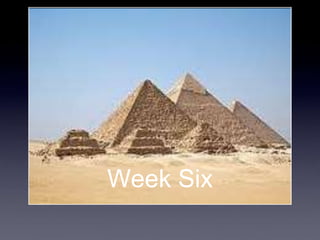
Ancient history week 6a
- 1. Week Six
- 2. The old kingdom in Egypt was also called the Age of the Pyramids.
- 3. King Khufu built the great pyramids at Giza. 2700-2200 BC
- 4. The Middle Kingdom would have been when Joseph was Prime Minister during the famine in Egypt. 2050-1800 BC
- 5. The Early Kingdom was during Amenhotep & King Tut’s reign. 1570-1300 BC
- 6. The Golden Age followed the Early Kingdom. It was from 1300-1090 BC.
- 7. Ramses II is also believed to be the Pharoah that lived during Moses’ time.
- 8. Ramses the great came to the throne at a young age and served for a time with his father.
- 9. He fought a powerful people in Asia called the Hittites and the Philistines who we read about in the Bible.
- 10. Ramses started a great building called the “Great Hall” whose columns were 78 feet high.
- 11. He built many buildings during this time.
- 13. The kingdom dwindled after his reign.
- 14. A mummy is a body of a person who has been preserved after death. There is a process to embalm the body and protect it from decay.
- 15. Egyptians believed the body had to be preserved to be okay in the afterlife.
- 16. We know that to be absent from the body, you are present with the Lord if you are a Christian. Egyptians did not believe in God.
- 17. It was almost an art to mummify an Egyptian. The body was washed & purified.
- 18. The next step was to remove the person’s organs.
- 19. The organs were individually wrapped with long strips of linen and placed in jars.
- 20. The body cavity was then stuffed with natron. The brain was removed through the nose using a long hook.
- 21. Since the ancient Egyptians thought the brain was unimportant, it was probably thrown away.
- 22. The body was then left to dry out for 40 days with a special chemical, then it was prepared for bandaging.
- 23. The body was then adorned with Gold, jewels—even the fingers and toes were covered with special gold caps.
- 24. The last layer of bandages went on & one last coat of resin.
- 25. They wrapped the head with a mummy mask.
- 26. Once the body was prepared, it was time for the funeral. People were hired to cry over the body.
- 27. The Egyptians had many ceremonies for the dead to be ready for the afterlife. They practiced this for over 3,000 years.
- 28. Many mummies were plundered and the gold was stolen off their bodies.